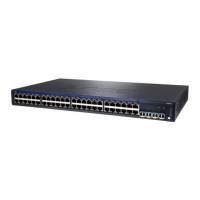user@switch> show diagnostics tdr interface ge-0/0/10
Interface TDR detail:
Interface name : ge-0/0/10
Test status : Passed
Link status : Down
MDI pair : 1-2
Cable status : Normal
Distance fault : 0 Meters
Polartiy swap : N/A
Skew time : N/A
MDI pair : 3-6
Cable status : Normal
Distance fault : 0 Meters
Polartiy swap : N/A
Skew time : N/A
MDI pair : 4-5
Cable status : Open
Distance fault : 1 Meters
Polartiy swap : N/A
Skew time : N/A
MDI pair : 7-8
Cable status : Normal
Distance fault : 0 Meters
Polartiy swap : N/A
Skew time : N/A
Channel pair : 1
Pair swap : N/A
Channel pair : 2
Pair swap : N/A
Downshift : N/A
3. Examine the Cable status field for the four MDI pairs to determine if the cable has a
fault. In the preceding example, the twisted pair on pins 4 and 5 is broken or cut at
approximately one meter from the ge-0/0/10 port connection.
NOTE: The Test Status field indicates the status of the TDR test, not the
cable. The value Passed means the test completed—it does not mean that
the cable has no faults.
The following is additional information about the TDR test:
• The TDR test can take some seconds to complete. If the test is still running when you
execute the show diagnostics tdr command, the Test status field displays Started. For
example:
user@switch> show diagnostics tdr interface ge-0/0/22
Interface TDR detail:
Interface name : ge-0/0/22
Test status : Started
• You can terminate a running TDR test before it completes by using the request
diagnostics tdr abort interface interface-name command. The test terminates with no
results, and the results from any previous test are cleared.
333Copyright © 2015, Juniper Networks, Inc.
Chapter 6: Troubleshooting Procedures

